Best Ways to Track Your Indoor Cycling Progress
Tracking Indoor Cycling Progress: Why It Matters
Indoor cycling has changed from a simple workout into a powerful training method that rivals outdoor cycling. After seven years as a fitness trainer, I’ve seen countless clients ask the same question: “How can I tell if I’m getting better?”
The answer lies in smart tracking. Measuring your progress turns every session into valuable insights that guide your fitness journey. Whether you’re grinding through the winter months or building base fitness year-round, proper tracking is the key to seeing real results.
Why Tracking Your Progress is a Game-Changer
Tracking transforms your indoor cycling from random workouts into purposeful training. I once had a client who spent months spinning without direction, wondering why her fitness had plateaued. Within weeks of implementing a proper tracking plan, she broke through that barrier and achieved personal records she never thought possible. This is a great way to get the most out of your training time. By focusing on tracking indoor cycling progress, you turn random sessions into a structured path to success.
Boost Motivation and Stay Consistent
Numbers don’t lie. Seeing concrete improvements (even small ones) keeps you coming back to the bike. When motivation wanes during those dark winter months, your progress data becomes your best cheerleader. It confirms that your hard work is paying off, and that keeps you on track with your fitness journey.
Set and Achieve Specific Goals
Vague goals like “get fitter” rarely work. Tracking allows you to set measurable specific goals, such as increasing your functional threshold power by 10 watts or maintaining a 90 RPM cadence for a longer ride. Having clear targets makes your training programs actionable and your progress easy to measure.
Get Better Results from Your Training Time
Without tracking, you’re training blind. Data reveals patterns and shows you which indoor workouts drive improvements. It also helps you understand when you need rest days, how your body responds to different training zones, and how to get better results from every session.
Extend this analysis by incorporating nutrition details into your logs, such as pre-ride carbohydrate intake, to correlate fueling with responses in power zones and overall session outcomes.
Essential Metrics to Monitor
To track your progress effectively, you must understand the key metrics. These numbers tell the story of your fitness.

Power Output (Watts): The Gold Standard
Power output is the most objective metric in cycling. Unlike heart rate, which can fluctuate based on stress or caffeine, watts provide a direct measurement of your work. It’s an invaluable tool for any serious indoor cyclist.
- Functional Threshold Power (FTP): Your FTP represents the maximum power you can sustain for one hour. Most training apps guide you through a 20-minute test to calculate it. This benchmark then divides your training into specific power zones. For example, sweet spot training is a highly effective way to increase your FTP by training at 88-94% of that number.
- Using a Power Meter: Smart trainers with built-in power meters offer convenience and accuracy. They measure your actual power output in real time, providing the foundation for structured training plans. I remember testing a client’s progress after three months of power-based training. Her FTP increased from 180 to 215 watts—a remarkable improvement that translated directly to stronger outdoor rides.
Heart Rate: A Key Indicator of Effort
While power is a great way to measure output, heart rate is a valuable tool for understanding your body’s response to training stress.
Heart Rate Zones for Indoor Cycling
Understanding heart rate zones is essential for tracking your indoor cycling progress. These zones help you tailor your training intensity to achieve specific fitness goals, from recovery to maximum effort.
| Zone | Intensity (% Max HR) | Purpose |
|---|---|---|
| Zone 1 | 50–60% | Promotes recovery and active rest |
| Zone 2 | 60–70% | Builds aerobic endurance |
| Zone 3 | 70–80% | Improves aerobic capacity |
| Zone 4 | 80–90% | Increases lactate threshold |
| Zone 5 | 90–100% | Boosts maximum effort and speed |
Note: This responsive table is optimized for mobile with horizontal scrolling or stacking. The percentages are based on the standard 5-zone model.
- Heart Rate Monitor: A heart rate monitor (like a chest strap or a wearable like the Apple Watch or Garmin Connect) gives you real time data. A chest strap is considered the gold standard for accuracy, especially during high-intensity efforts.
- Heart Rate Zones: Understanding your heart rate zones for different intensities is crucial for a balanced training plan. Training in Zone 1, for instance, promotes recovery, while Zone 4 builds your lactate threshold. Combining heart rate zones with power zones gives you a complete picture of your effort level and physical response.
- Heart Rate Variability (HRV): More advanced tools and apps now track your heart rate variability. A higher HRV reading often indicates that your body is well-rested and ready for a hard workout. This metric offers valuable insights into your recovery and helps prevent overtraining.
Cadence: Efficiency and Injury Prevention
Cadence—your pedaling rate in revolutions per minute (RPM)—is often overlooked. It significantly impacts your efficiency and long-term joint health.
- Using a Cadence Sensor: A cadence sensor is a great way to improve your form. Most recreational cyclists pedal too slowly, mashing big gears instead of spinning efficiently. The sensor provides instant feedback to help you develop a smooth, sustainable pedaling style.
- Cadence and Power: Higher cadences, typically 90-100 RPM, can produce more sustainable power output while reducing stress on your knees and hips. Lower cadences might feel easier at first, but they can create more muscular fatigue.
Beyond the Numbers: Recovery and Sleep
Beyond the classic cycling metrics, your sleep quality and recovery status are key to making progress. The best way to get stronger is by allowing your body time to adapt to training stress.
- Rest Days: Your body gets stronger during rest days, not during the workout itself. Integrating these into your training plan is non-negotiable.
- Sleep Quality: Many wearables and mobile apps now track sleep quality. Poor sleep can hinder recovery and make a hard workout feel much more difficult. Monitoring this metric helps you understand your body’s readiness for training.
- Nutrition: Complement sleep tracking with nutrition logging to refine recovery strategies. For instance, post-workout intake of a 3:1 or 4:1 protein-to-carbohydrate ratio (such as Greek yogurt with fruit) supports glycogen replenishment and muscle repair, directly influencing subsequent session performance.
Top Tools and Technology for Indoor Cycling
The indoor cycling platform has evolved rapidly in recent years. These tools create an immersive experience and provide the data you need to improve.
Smart Trainers and Smart Bikes: The Best Options
Smart trainers have revolutionized indoor cycling by automatically adjusting resistance and providing accurate power measurement. This is a good reason to invest in one.
- Wheel-On vs. Direct-Drive: Wheel-on trainers are affordable and easy to set up but can be less accurate. Direct-drive trainers, which replace your bike’s rear wheel, are more expensive but offer superior accuracy, a more realistic ride feel, and a quieter experience.
- Essential Features: Modern smart trainers can simulate gradients, headwinds, and drafting. This technology transforms your living room into virtual worlds where you can climb Alpine passes or sprint through city streets. It is great for making indoor training more engaging.
Virtual Cycling Platforms: More Than Just a Game
Plenty of indoor cycling apps are available, each offering a unique experience.
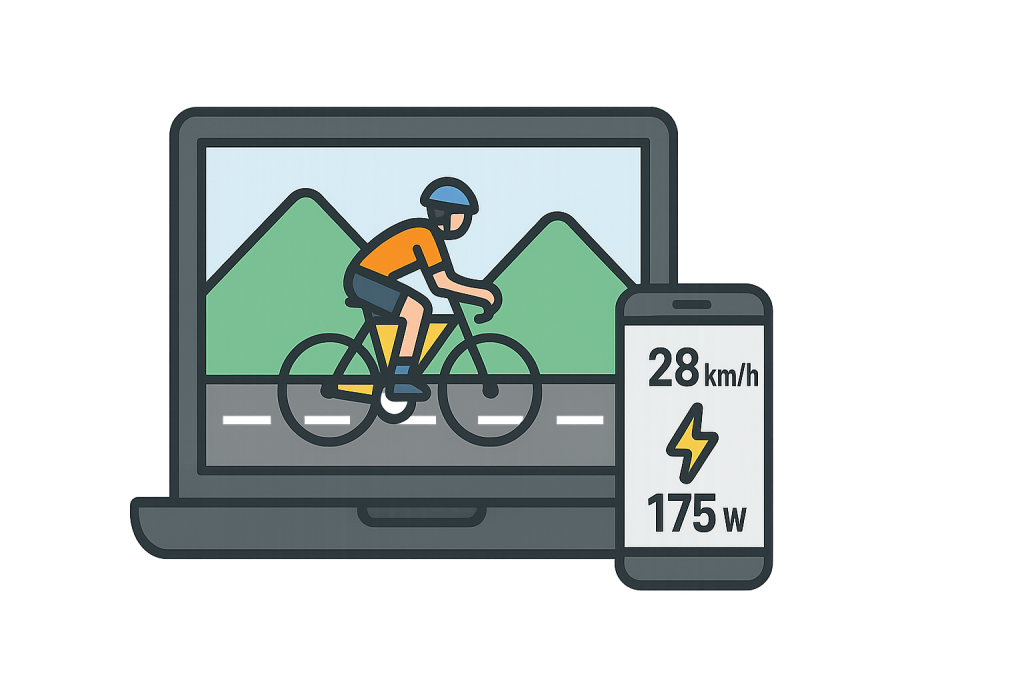
- Zwift: The Zwift app combines gaming with serious training. You can join virtual group rides, compete in races, or follow structured workout plans. The Zwift ride environment hosts thousands of cyclists simultaneously, recreating the social aspect of cycling. Platforms like Zwift not only facilitate virtual rides but also enable logging of nutrition alongside ride data, allowing users to track how fueling impacts sustained efforts in simulated environments.
- Wahoo SYSTM and TrainingPeaks: These platforms focus on systematic performance improvement. They offer structured training programs and personalized training plans created by professional coaches to help you reach specific goals. They also provide advanced analytics for valuable insights into your fitness and recovery.
- TrainerRoad: This platform is known for its “no-frills” approach. It focuses purely on structured, data-driven indoor workouts to increase your fitness with the least amount of training time.
- Rouvy: This app provides a unique, augmented reality experience by letting you ride on real-world video routes. It’s the perfect blend of scenic outdoor rides with the control of an indoor trainer.
Building a Successful Indoor Training Plan
Having the right tools is only part of the equation. You also need a smart plan.
Setting Specific Goals
Develop personal goals for the winter months or for a specific event. Maybe you want to increase your FTP by 15 watts before spring, or complete your first virtual century ride. I worked with a client who set a goal to improve her climbing power during the off-season. We focused on sweet spot intervals and hill simulations. When spring arrived, she conquered climbs that previously dropped her from virtual group rides.
The Power of Structured Workout Plans
Random workouts might feel satisfying, but structured workout plans drive systematic improvements. Periodization (the strategic arrangement of training phases) maximizes adaptations while preventing overtraining.
- A Simple Training Week: A balanced week might include an endurance ride (Zone 2), a hard interval session (Zone 4-5), and a recovery ride (Zone 1). This mix of intensities ensures you’re building all aspects of your fitness.
- Recovery Is Key: Recovery days and rest days are when your body adapts to training stress. I’ve seen too many cyclists burn out by ignoring rest. Smart tracking helps you know when you need to rest before your body forces it with an injury.
Connecting Indoor and Outdoor Cycling
Your indoor training can directly improve your outdoor cycling. The controlled environment of an indoor trainer is perfect for focused interval sessions and FTP testing. The gains you make indoors translate directly to your performance on the road. Many modern training apps and platforms, like Garmin Connect, seamlessly combine your indoor use and outside rides data, giving you a complete picture of your fitness journey.
Troubleshooting Common Issues
Every indoor cyclist faces challenges. Here’s how to handle common issues.
- Combatting Monotony: If your workouts feel stale, try a different app, join a new virtual group ride, or add some weight training and stretching to your routine. The variety will keep you engaged.
- Dealing with a Plateau: If your numbers stop improving, you may need a recovery week or a change in your training plan. Sometimes, a few extra rest days can be the key to breaking through a plateau.
- Staying Motivated: Finding motivation through the social aspect of platforms like Zwift is key. The sense of community and friendly competition keeps you pedaling on days you might not want to.
Getting Started: A Step-by-Step Guide
You don’t need expensive equipment to start tracking your progress. The most effective system is one you’ll actually use consistently.
- Choose the Right Gear: The best options for you depend on your budget. A simple stationary bike with a speed sensor is a good starting point. As you advance, a smart trainer with a built-in power meter and a chest strap for accurate heart rate data are great upgrades.
- Sync Your Devices: Most modern devices use Bluetooth and ANT+ for seamless connectivity. Most mobile apps walk you through the pairing process for your heart rate monitor and cadence sensor.
- Consistency Is Key: Consistency trumps intensity every time. Three moderate workouts per week are far better than one heroic effort followed by a week of recovery. Treat your workouts like important meetings.
Final Thoughts on Tracking Your Progress
The best way to track your progress is a personal one. Your approach should match your goals, budget, and technical comfort. Start simple, and add complexity as your needs evolve. The best cycling app for you is the one you will use regularly.
The indoor cycling platform has advanced rapidly in recent years. We are in the golden age of indoor training, with a variety of apps and platforms to choose from. This competition benefits every indoor cyclist through better key features, more content, and improved user experiences.
Start tracking your indoor cycling progress today. Your future self will thank you for the data-driven improvements you’re about to make.
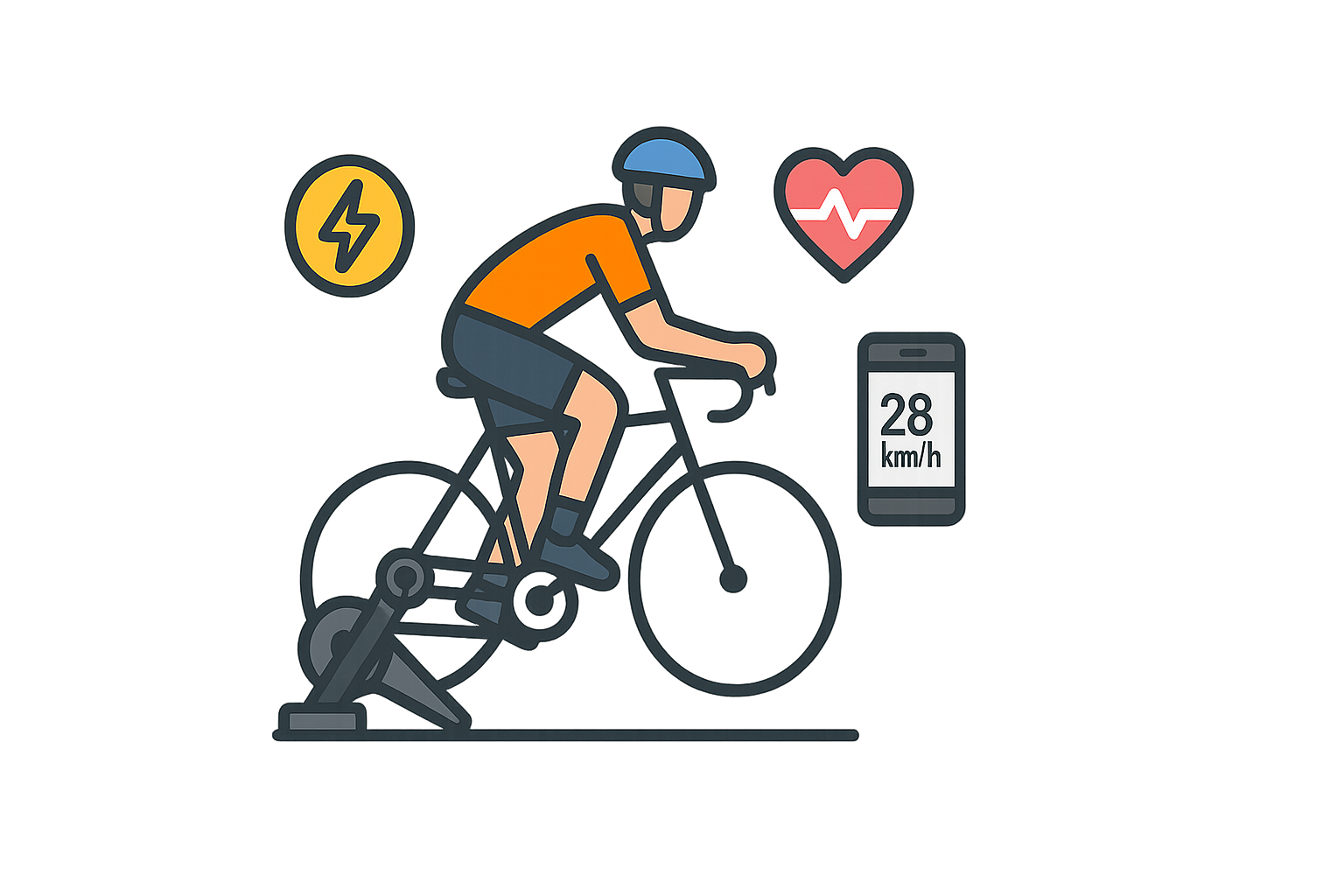
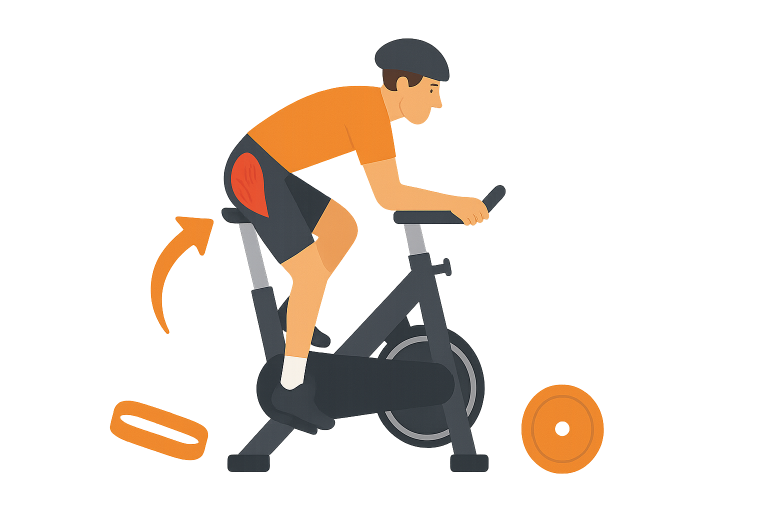

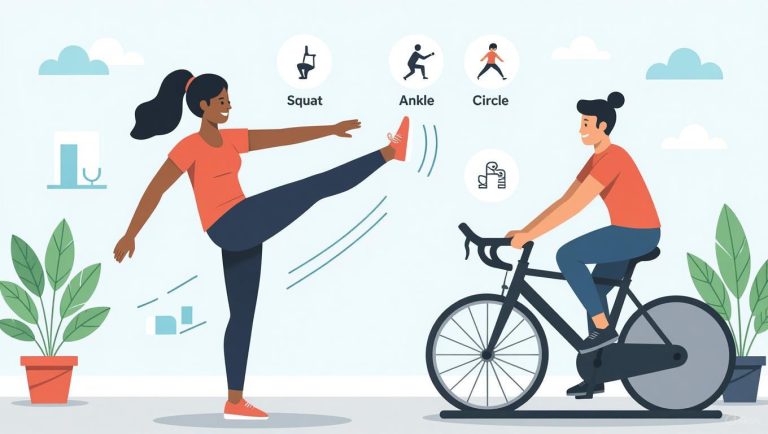
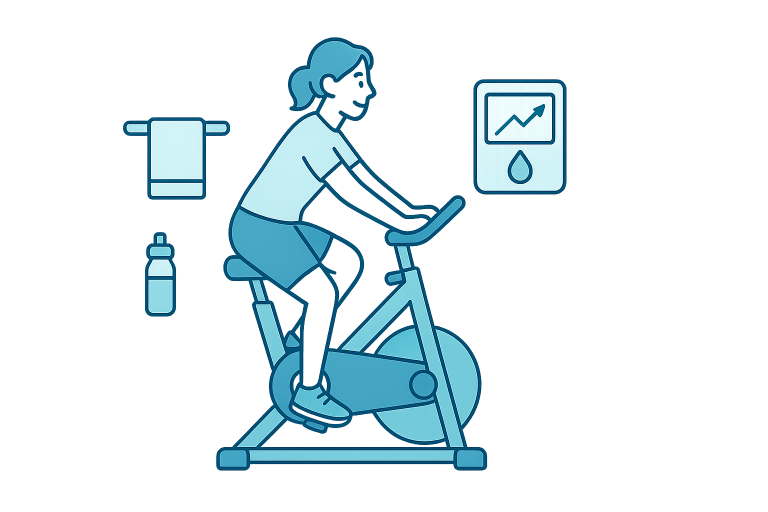

![The Best HIIT Over 50 For Women [No Equipment Needed]](https://fiit4lyfe.com/wp-content/uploads/2023/09/HIIT-Over-50-Compressed-768x432.png)